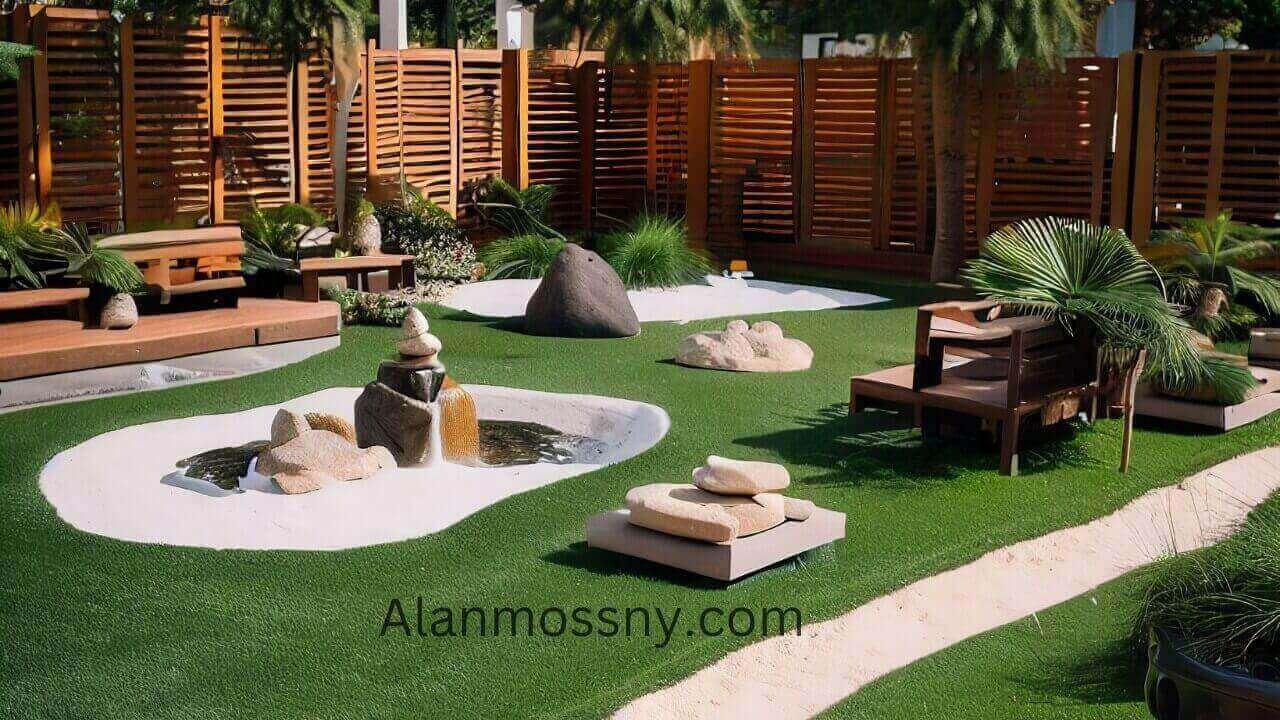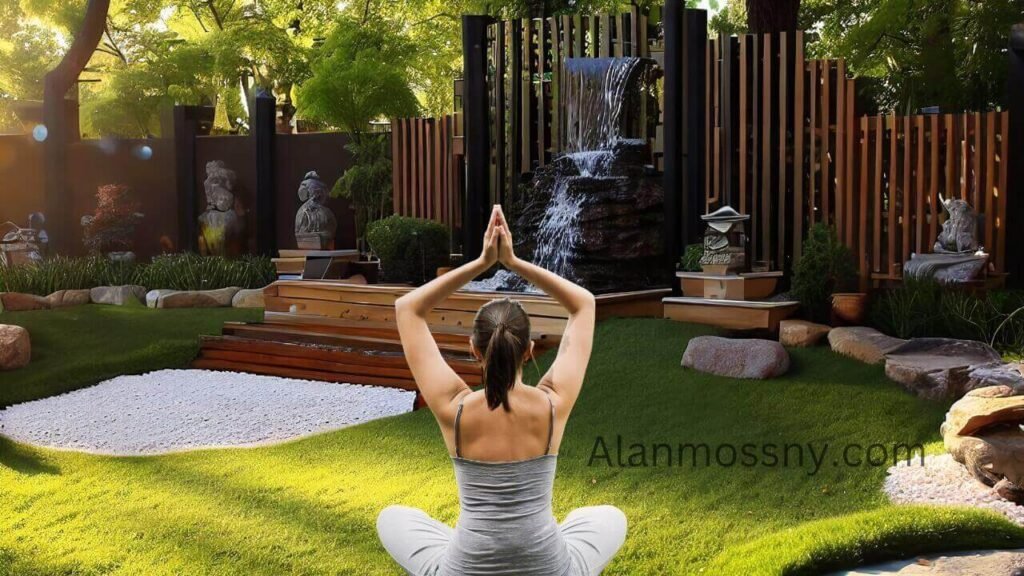How to Create an Outdoor Meditation Space: Expert’s Guide
Meditation is a fantastic practice that helps relax the mind and body. You can attain mental clarity and emotional stability by doing so. It has been around for ages and brings many advantages like easing stress, sharpening concentration, and improving your general wellness.

Outdoor meditation is especially effective because the natural surroundings can enhance the experience by providing a relaxing and refreshing atmosphere. Discover the step-by-step guide on How to Create an Outdoor Meditation Space that promotes serenity and mindfulness.
Table of Contents
Benefits of outdoor meditation
Outdoor meditation allows you to connect with nature, which can amplify the calming effects of meditation. Spending time in natural environments has been shown to reduce tension, improve mood, and enhance ability to think. Meditating outside lets you enjoy the calming noises, views, and smells of nature. This can make your meditation even better and help you feel good overall.
Importance of personalizing your meditation space
Personalizing your meditation area is essential if you want to create a location that feels appropriate for you and enhances peace and relaxation. By making the area fit your needs, you can make sure it’s a safe place where you can completely lose yourself in meditation.
Choosing the Right Location
Choosing the right location is one of the most important things to do when creating an outdoor meditation space.
Evaluating space availability
Consider your outside space and how much space you need for sitting and other items while choosing a meditation site. Make sure the space is big enough for what you need but still feels private and cozy.
Assessing privacy and noise levels
Choose a location that offers an adequate level of privacy and is relatively free from noise and distractions. A quiet, secluded area will allow you to focus on your practice without interruptions, creating an optimal meditation experience.
Considering sun exposure and weather conditions
Take into account the amount of sun exposure and prevailing weather conditions in your chosen location. Ideally, your meditation space should offer a balance of sun and shade, providing you with a comfortable environment throughout the day. Additionally, consider whether the area is protected from wind and rain, as this will affect the usability of your space.
The importance of natural surroundings
Having trees, flowers, and other nature things around you can make your meditation experience much better. The visual appeal and soothing scents of plants can aid in relaxation, while the presence of trees can provide shade and a sense of stability. When choosing your location, prioritize areas with a variety of natural elements that contribute to a serene and tranquil atmosphere.
Creating a Solid Foundation
Options for flooring
Grass: Soft and natural, grass is a popular choice for meditation spaces. It requires regular maintenance, such as mowing and watering, but offers a comfortable and eco-friendly surface.
Sand: Sand is another natural flooring option that provides a soft and supportive surface. It requires minimal maintenance, but may need occasional raking to maintain a smooth and even surface.
Stone: Stone flooring, such as pebbles or flagstones, offers a durable and low-maintenance option that can blend seamlessly with the natural environment. Ensure that the stones are level and secure to prevent discomfort or tripping hazards.
Wood decking: Wood decking can create a stable and visually appealing foundation for your meditation space. It requires regular maintenance, such as staining or sealing, to preserve its appearance and durability.
Ensuring level and stable ground
Regardless of the flooring option you choose, ensure that the ground is level and stable to prevent uneven surfaces or wobbling seating. This will provide a comfortable and secure foundation for your meditation practice.

Designing a Comfortable Seating Area
A. Cushions and pillows: Cushions and pillows offer a versatile and comfortable seating option for meditation. They can be easily adjusted to accommodate various positions and preferences.
Benches: Benches provide a sturdy and supportive seating option that can accommodate multiple people. Pick benches made from strong materials like wood or metal, and make sure they are comfy for sitting a long time.
Meditation chairs or stools: Meditation chairs or stools made just for this can give extra help and comfort for people who find it hard to sit on the ground or need support for their back. These seating options often feature ergonomic designs to promote proper posture during meditation.
Choosing the right fabric and materials
Look for fabrics that are weather-resistant and simple to clean when selecting pillows. Consider materials like outdoor-grade canvas, synthetic fibers, or moisture-resistant foam for cushions and pillows. For benches, chairs, and stools, opt for materials like wood, metal, or weather-resistant plastics that can withstand outdoor conditions. For benches, chairs, and stools, choose materials such as wood, metal, or strong plastics that can handle being outside.
Personalizing seating based on individual needs
To ensure maximum comfort during meditation, choose seating options that cater to your specific needs. If you require additional support for your back, consider a meditation chair or stool. If you like seating that can change easily, choose cushions and pillows that can be moved around. The main thing is to find a way to sit that lets you stay comfy while you meditate.
Incorporating Natural Elements
Plant life and garden design
Choosing low-maintenance plants: For a low-maintenance meditation setting, choose succulents, ferns, or decorative grasses. These plants typically require less water and attention than other varieties, making them an ideal choice for busy individuals.
Aromatic plants for relaxation: Lavender, chamomile, or eucalyptus can be added to your meditation environment to improve its relaxing benefits. These plants not only provide visual appeal but also emit soothing scents that can promote relaxation and stress relief.
Water features
Fountains: Fountains can create a peaceful ambiance by providing the soothing sound of flowing water. They can also help to mask noise from the surrounding environment, making them a valuable addition to any meditation space.
Ponds: Ponds offer a tranquil and visually appealing element for your meditation space. They can support aquatic plants and wildlife, adding to the overall natural atmosphere.
Waterfalls: Waterfalls provide both visual and auditory appeal, creating a serene and captivating focal point for your meditation area.
Fire elements
Outdoor fireplaces: Outdoor fireplaces can create a warm and inviting atmosphere for your meditation space, making it an ideal location for evening or cooler weather meditation sessions.
Fire pits: Fire pits offer a more casual and portable option for incorporating fire into your meditation space. They can be easily moved and provide a cozy focal point for meditation and relaxation.
Using additional natural elements
Incorporate other natural elements, such as rocks, shells, or crystals, to further enhance the tranquility and beauty of your meditation space. These items can be used as decorative accents or arranged in patterns and formations to create a sense of balance and harmony.
Enhancing Privacy and Seclusion
Fences and barriers
Fences and barriers can provide a physical boundary for your meditation space, creating a sense of privacy and separation from the surrounding environment. Choose materials and designs that complement the natural elements in your space, such as wood, stone, or lattice fencing.
Hedges and shrubs
Planting hedges or shrubs can create a living, green barrier that offers privacy and noise reduction. Opt for evergreen species to ensure year-round coverage.
Privacy screens and curtains
Privacy screens or outdoor curtains can provide a temporary and flexible solution for enhancing seclusion in your meditation space. Choose weather-resistant materials and ensure that they can be easily removed and cleaned when necessary.
Creating an Inviting Atmosphere
Outdoor lighting
Solar-powered lights: Opt for energy-efficient solar-powered lights to illuminate your meditation space without the need for electrical wiring.
String lights: Hang string lights to create a warm and magical ambiance during evening meditation sessions.
Lanterns: Use lanterns to cast a soft and calming glow throughout your meditation area.
Soft and calming colors
Incorporate soft and calming colors into your meditation space’s design to promote relaxation and serenity. Consider using shades of blue, green, or earthy tones for your seating, cushions, or other decorative elements.
Wind chimes and outdoor soundscapes
Adding wind chimes or other outdoor soundscapes can enhance the auditory experience of your meditation practice. Choose chimes made from natural materials, such as bamboo or wood, for a more soothing and organic sound.
Aromatherapy and natural scents
Use aromatherapy to your advantage by using natural smells such as lavender or eucalyptus into your outdoor meditation location. Plant fragrant flowers, and use essential oil diffusers, or light-scented candles to create a calming and relaxing atmosphere.
Setting Up a Meditation Altar
Choosing a focal point
Select a focal point for your meditation altar, such as a statue, artwork, or natural object. This focal point should inspire a sense of peace and reflection and align with your spiritual or religious beliefs.
Incorporating meaningful objects
Personalize your altar with meaningful symbols or objects that resonate with your spiritual practice or personal values. These might include crystals, candles, religious texts, or mementos from a significant life event.
Keeping it simple and clutter-free
Maintain a clean and clutter-free altar to promote focus and concentration during meditation. Regularly clean and organize your altar, removing any unnecessary items or distractions.
Integrating Mindfulness Tools
Outdoor yoga props
Include outdoor yoga props, such as mats, blocks, or straps, to support your meditation practice and encourage physical relaxation.
Aromatherapy and incense
Boost your meditation by using nice smells from things like oils or incense sticks. Pick relaxing smells like lavender, sandalwood, or frankincense. These smells will help make a peaceful and relaxing space for you to meditate in.
Meditation bells and singing bowls
Incorporate meditation bells or singing bowls into your practice to signal the beginning and end of your meditation session. The resonant tones of these instruments can also help to promote relaxation and focus.
Maintaining and Caring for Your Space
Regular cleaning and upkeep
To keep your outdoor meditation space inviting and serene, establish a regular cleaning and maintenance routine. Remove leaves, debris, and dirt from the area, clean cushions and seating, and ensure that all elements, such as lighting or water features, are in proper working order.
Seasonal considerations
Adapt your meditation space to accommodate seasonal changes, such as adding shade during hot summer months or incorporating blankets and warm seating options for colder weather. Adjust your plant selections based on the season to ensure a visually appealing and vibrant space year-round.
Adapting your space over time
As your meditation practice evolves, so too should your outdoor meditation space. Continuously assess your space’s effectiveness and make adjustments as needed, incorporating new elements or removing those that no longer serve your practice.
Additional Tips for Creating Your Perfect Meditation Space
1. Make it personal
Remember that your outdoor meditation space should reflect your unique preferences and needs. Feel free to incorporate elements that have personal significance or resonate with you, even if they aren’t commonly associated with meditation spaces.
2. Consider accessibility
Design your meditation space with accessibility in mind. Ensure that it is easy to access and navigate, with a clear path leading to the space and enough room to comfortably move around.
3. Allow for flexibility
Allow your outdoor meditation space to be adaptable and versatile. Make a setup that you can change easily for different things like yoga or group meditation, or to adjust when your practice changes.
4. Create a sense of balance
Strive for balance in your meditation space, both visually and energetically. Try to make a nice mix of colors, how things feel, and nature stuff that helps you feel balanced and peaceful.
5. Develop a ritual
Establish a ritual or routine for entering and leaving your meditation space. This can help to signal the transition from everyday life to a mindful and focused state, reinforcing the importance of your meditation practice.
6. Keep a meditation journal
Consider keeping a meditation journal near your outdoor meditation space to document your experiences, insights, and progress. Reflecting on your practice can help to deepen your understanding of yourself and your meditation journey.
Conclusion Of How to Create an Outdoor Meditation Space
Creating an outdoor meditation space that aligns with your personal preferences, needs, and spiritual beliefs can greatly enhance your meditation practice. By carefully considering each aspect of your space, from location and design to the incorporation of natural elements and meaningful objects, you can create a serene sanctuary where you can relax, ponder, and connect with yourself on a deeper level.
Stay with us to beautify your sweet home.
Frequently asked questions: How to Create an Outdoor Meditation Space
How big does an outdoor meditation space need to be?
The size of your outdoor meditation space depends on your personal preferences and available space. A small, intimate area can be just as effective as a larger space, provided it accommodates your seating, altar, and any additional elements you wish to incorporate.
Can I create a meditation space on a budget?
Absolutely. You can create an outdoor meditation space on a budget by repurposing existing items, using natural elements found in your surroundings, and choosing low-cost or DIY options for seating and decorations.
How can I keep bugs and pests away from my meditation area?
To keep bugs and pests at bay, consider using natural repellents such as citronella candles, planting pest-repelling plants like lemongrass or marigolds, or using a screened canopy to enclose your meditation space. Regularly clean your area and remove any standing water to minimize the attraction of insects and pests.

